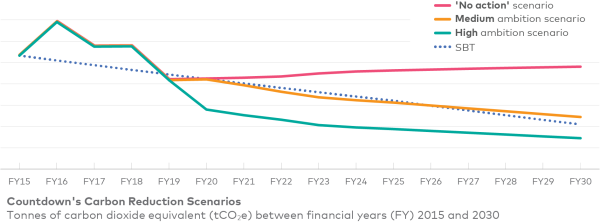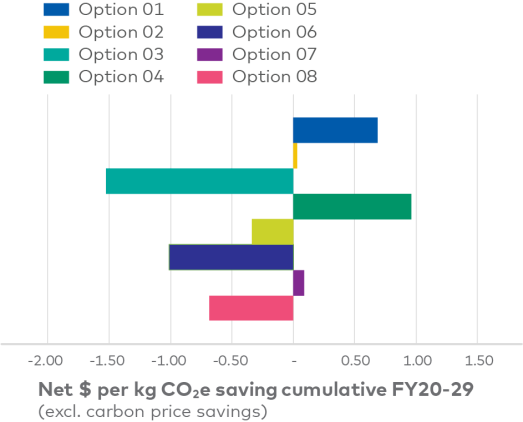Countdown wanted to set a science-based target (SBT) to reduce their emissions and then plan how to achieve this target.
We worked with Countdown to calculate their specific carbon reduction target based on approaches provided by the Science Based Targets initiative. In preparation, we reviewed their existing carbon inventory (scope 1 and scope 2 emissions) and updated it to be in line with the international standards — ISO 14064-1:2019 and the Greenhouse Gas Protocol. This review provided a baseline for the target and reduction plan, which was the financial year 2015 (FY15).
Creating a carbon reduction pathway guides Countdown on their strategy
This project involved:
- reviewing and confirming Countdown’s scope 1 and 2 emissions for FY15
- developing a Countdown-specific SBT
- projecting Countdown’s emissions to FY30 if no action is taken
- analysing a broad range of opportunities for carbon reduction
- developing a carbon reduction plan for the named emission sources.
Analysing different scenarios makes it possible to prioritise effective changes
We held a workshop with experts at Countdown to identify and prioritise eight ideas to reduce carbon emissions. With these ideas, we developed two scenarios for Countdown’s carbon reduction pathway: ‘high ambition’ and ‘medium ambition’.
With an analysis of different scenarios, Countdown were able to identify and prioritise the areas where they could make effective changes.
Countdown will transition to low carbon alternatives faster if they follow the most ambitious scenario
We evaluated both scenarios against Countdown’s SBT and a ‘no action’ scenario. The ‘no action’ scenario is based on the status quo of the baseline year (2015). It reflects the outcome of future business activities and related emissions by applying expected growth rates.
The ‘high ambition’ scenario reflects a faster transition to low carbon alternatives, including the purchase of 100 percent renewable electricity.
We compared the eight options for carbon reduction to understand their real-world value
Calculating the net cost of each option for every kilogram of carbon dioxide equivalent that could be saved shows us which options are most cost effective. We found four of the eight options have negative net cost values. This means that the total savings (from improved energy efficiency, and carbon costs savings) outweigh the capital expenditure (including capital and maintenance costs).
Carbon reduction projects help businesses take meaningful climate action
By understanding their emissions profile, Countdown can set reduction targets that are aligned with science and take meaningful climate action.
In addition, this project means Countdown can:
- agree internally on their carbon strategy
- identify carbon hotspots
- understand the scope of their carbon target more clearly
- plan how to take action
- budget using the indicative costing of scenarios
- assess different opportunities for carbon reduction.
Check out our Carbon services page for more information on carbon reduction

